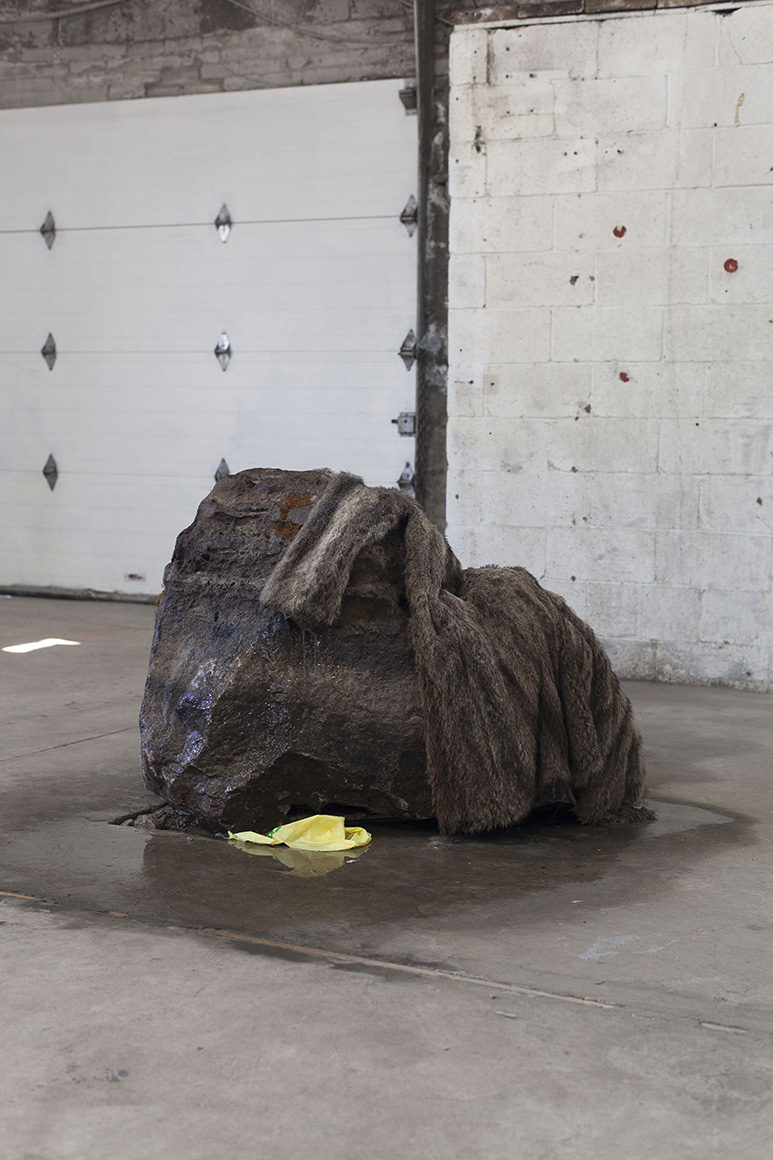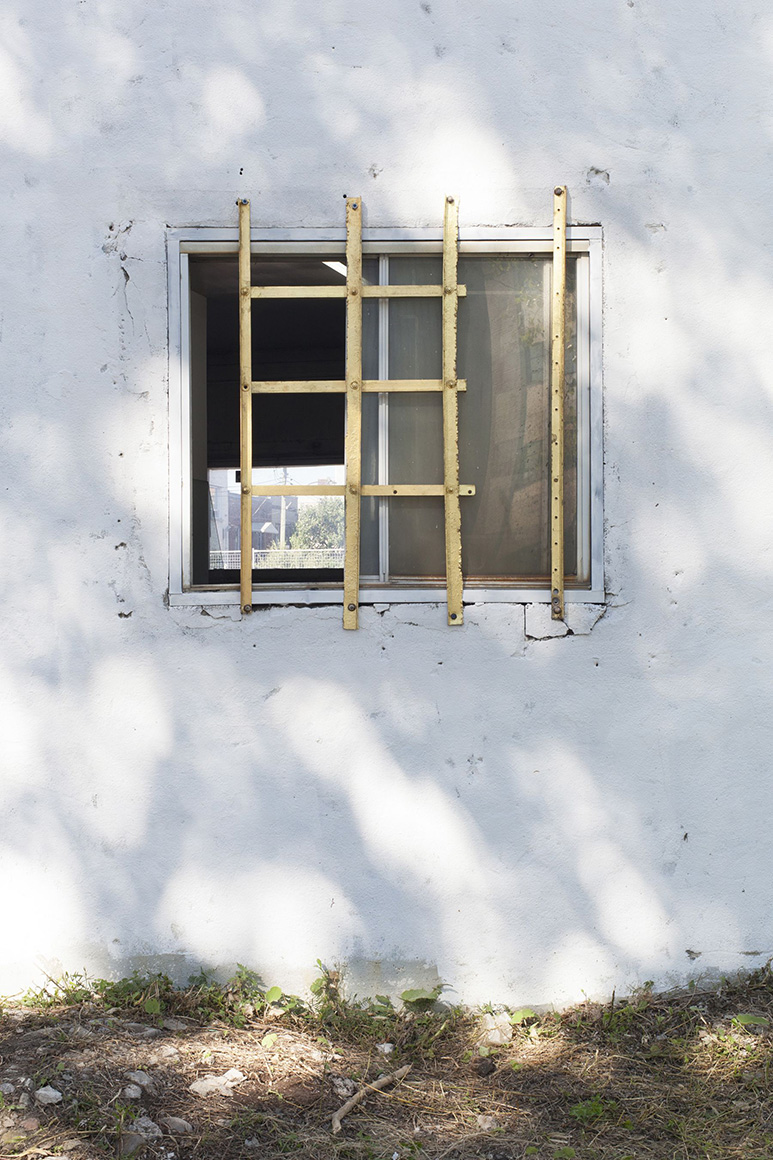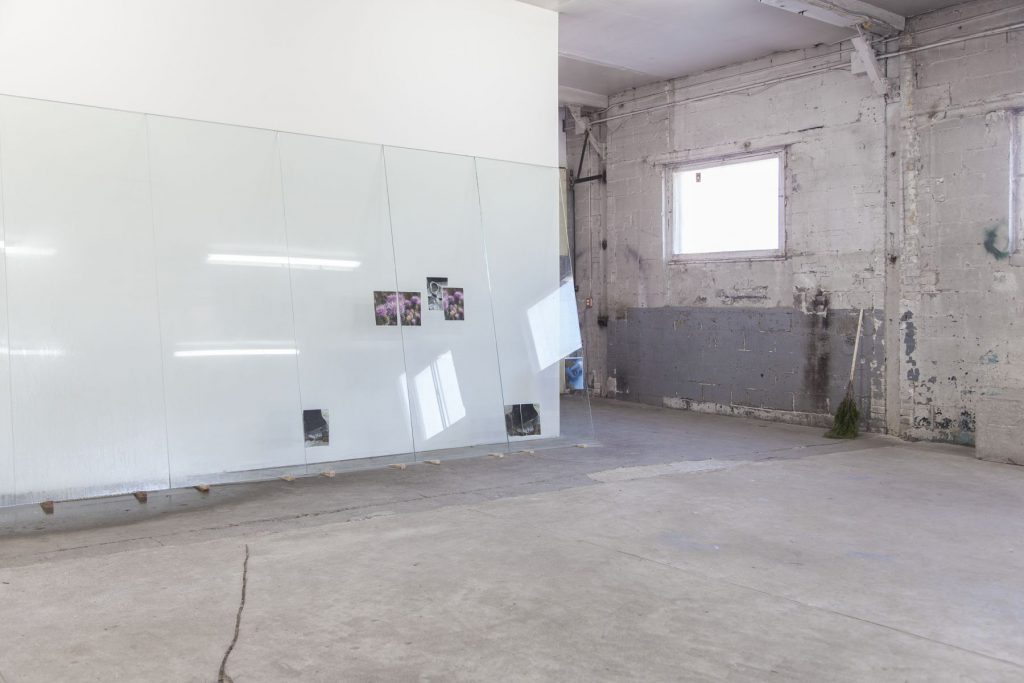Folly
17 January 2019
By Chris Andrews
A water-misting system attached to the ceiling of VIE D’ANGE gallery sprayed the subtle, unobtrusive artworks of Abbas Akhavan’s exhibition, Folly. Untitled (2018) is a homogeneous arrangement of materials comprised of an erratic boulder, a vintage fur coat and a plastic shopping bag. From a distance, the fur coat looked like moss on the rock, as drops of water hitting the hair of the vintage garment eventually rolled off onto the pill-yellow bag sourced from a local fruiterie. The misting system above was precariously tacked on, and held itself almost apologetically to the space’s gruff ceiling—as if an uninvited dinner guest. Sheets of glass leaned against a wall across from the sculptural installation, with inkjet-printed images sourced from the Internet taped to their verso, thus protected from the threatening mist. On the wall next to the sheets of glass, a broom furnished from a cedar branch leaned. Entitled Study for a Garden (2018) its flat, scale-like leaves brushed the cold floor. Everything was safe, but imperiled—something could slip or burst, and the sensitivities of the materials overwhelmed; upsetting Folly’s graceful negotiation of permanence and impermanence.
The found images in Untitled (2018) ranged in depiction from a gloved hand around a dog’s snout, horse hooves in muck, purple flowers akin to a computer’s stock background image, to a photograph of Pierre Ayot’s public sculpture of a cross laying on its side. Folly operated largely on paradox: the images were kept safe from water and the resulting decomposition, while the sculptural works grew waterlogged. If the exhibition was left to its own processes, we could have come back to see it covered in a layer of moss and spores, the laser-printed Internet images glaringly unchanged.

This is the folly, the paradox in Akhavan’s antithetical arrangements: to have these images preserved whilst everything else is exposed and vulnerable. The images could be reprinted at the touch of a few buttons, unlike the other objects, so why then do the images sit atop a hierarchy? While standing in the gallery, I wished to see it all decay, the playing field made flat; to watch the misting of the water making the images wet and ripped, to see what succumbs to degradation from a light-mist above, and how their value would be interrogated through this gesture.
The crumbling tile on VIE D’ANGE’s walls leak history and it’s materials, it’s remnants. The space flaunts its previous use as an auto shop, a shell that has remained largely intact. Its past is archived within the building structure itself, oozing with what came beforehand: a metal sheet covers a pre-existing hole, grime remains compacted deep in the tile grout, and on the stained cement floor, a slow-spreading pool of water collects where similar puddles of oil may have gathered previously. Akhavan’s acknowledgment of this history is a rejection against the neutral desires of institutional spaces for art, the aspiration and practice of erasing histories—what has been referred to as the “museum effect”. (2)
On the building’s exterior, Akhavan rendered the foreboding security bars on the windows almost inviting, by covering them in 24 karat gold leaf and titling the gesture, Claim (2018), a further mark of cultural contradiction. Claim has since become a permanent installation at VIE D’ANGE. Through its practices of protection and opposingly, exposure, the exhibition interrogates the ways in which certain histories are preserved and privileged, while others are neglected, like the dripping fur in Untitled.

At times, Folly struggled for cohesion: the printed images appeared sorely out of place in relation to the unmonumental sculptural works, and a rather inaccessible roof piece, whose “art for documentation” quality made it seem cold, without intimacy towards the other included pieces. Akhavan’s creation of new environments, or even new ecosystems—as seen through the constant misting of water in the gallery—forgoes an opportunity to speak more directly to current (alarming) environmental issues. In lieu, the exhibition exposes the practices of appearance and disappearance, acts that alter histories and ultimately lead to the governing of value. What Akhavan’s work does do is question the processes of protection and destruction which expose themselves in major and minor ways in contemporary culture, such as the removal of content from social media platforms, the erasure of peoples and histories from state–run records, and the invisibility of certain bodies in the collective archive. The exhibition moves towards the important practice of acknowledging histories displaced, of contextualizing art practices outside of a self-reflexive vacuum. These gestures are a much needed reminder, especially in a year of a shaky art market and uncertain futures.
- As mentioned in the material listing by the artist. Erratic is in reference to a rock which differs from the surrounding rock, believed to have been brought from a distance by glacial action.
- James Putnam has written extensively about the term, “museum effect”. See “Art and Artifact: The Museum as Medium” published by Thames & Hudson, 2009.
Folly ran from September 14 – October 14, 2018 at VIE D’ANGE in Montreal.
Feature image: Untitled, 2018 (left) and Study for a Garden, 2018 (right) by Abbas Akhavan. Photo by Simon Belleau, courtesy of the artist and VIE D’ANGE.



